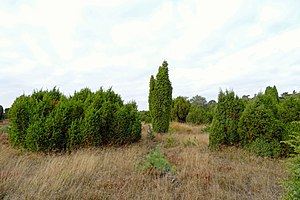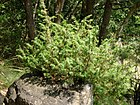Note: This is a project under development. The articles on this wiki are just being initiated and broadly incomplete. You can Help creating new pages.
Difference between revisions of "Juniperus communis"
| Line 1: | Line 1: | ||
[[File:20161013 Jeneverbessenbos1.jpg|thumb|right]] | [[File:20161013 Jeneverbessenbos1.jpg|thumb|right]] | ||
| + | '''Juniperus communis''' is a very variable, evergreen shrub or a tree with an erect stem. It can grow up to 12 metres tall, though it is more commonly within the range 1 - 3 metres. The branches can be erect or spreading, so crown shape is very variable. | ||
==Uses== | ==Uses== | ||
| − | {{Uses|}}, {{Uses|}}, {{Uses|}}, {{Uses|}}, {{Uses|}}, {{Uses|}}, {{Uses| | + | {{Uses|Kidney problems}}, {{Uses|Bladder problems}}, {{Uses|Cystitis}}, {{Uses|Digestive problems}}, {{Uses|Chronic arthritis}}, {{Uses|Gout}}, {{Uses|Rheumatic conditions}}.<ref name="Uses"/> |
==Parts Used== | ==Parts Used== | ||
| − | {{Parts Used|}}, {{Parts Used| | + | {{Parts Used|Fruits}}, {{Parts Used|Stems}}, {{Parts Used|Leaves}}. |
==Chemical Composition== | ==Chemical Composition== | ||
| Line 28: | Line 29: | ||
==Habit== | ==Habit== | ||
| − | {{ | + | {{HabitEvergreen shrub|}} |
==Identification== | ==Identification== | ||
| Line 47: | Line 48: | ||
==Mode of Propagation== | ==Mode of Propagation== | ||
| − | {{Propagation|}} | + | {{Propagation|Seeds}}, {{Propagation|Cuttings of mature wood}}, {{Propagation|Air layering}}. |
==How to plant/cultivate== | ==How to plant/cultivate== | ||
| − | <ref name="How to plant/cultivate"/> | + | Juniperus communis is a very cold-hardy plant, able to tolerate temperatures down to around -40°c when fully dormant. However, although the fully dormant plant is very cold-tolerant, the young growth in spring can be damaged by late frosts.<ref name="How to plant/cultivate"/> |
==Commonly seen growing in areas== | ==Commonly seen growing in areas== | ||
| − | {{Commonly seen|}}, {{Commonly seen|}}, {{Commonly seen|}}, {{Commonly seen| | + | {{Commonly seen|Pine woods}}, {{Commonly seen|Moorland}}, {{Commonly seen|Calcareous river banks}}, {{Commonly seen|Mixed woods}}. |
==Photo Gallery== | ==Photo Gallery== | ||
| Line 67: | Line 68: | ||
<references> | <references> | ||
| − | <ref name="chemical composition">[ | + | <ref name="chemical composition">[Chemistry]</ref> |
| − | <ref name="Leaf">[ | + | <ref name="Leaf">[Morphology]</ref> |
| − | <ref name="How to plant/cultivate">[ | + | <ref name="How to plant/cultivate">[http://temperate.theferns.info/plant/Juniperus+communis Cultivation]</ref> |
<ref name="Uses">Indian Medicinal Plants by C.P.Khare</ref> | <ref name="Uses">Indian Medicinal Plants by C.P.Khare</ref> | ||
</references> | </references> | ||
==External Links== | ==External Links== | ||
| − | * [ ] | + | * [https://vikaspedia.in/agriculture/crop-production/package-of-practices/medicinal-and-aromatic-plants/juniperus-communis Juniperus communis on vikaspedia.in] |
| − | * [ ] | + | * [https://www.sciencedirect.com/topics/agricultural-and-biological-sciences/juniperus-communis Juniperus communis on sciencedirect.com] |
| − | + | ||
[[Category:Herbs]] | [[Category:Herbs]] | ||
[[Category:Pages without herbs images]] | [[Category:Pages without herbs images]] | ||
Revision as of 16:16, 27 May 2020
Juniperus communis is a very variable, evergreen shrub or a tree with an erect stem. It can grow up to 12 metres tall, though it is more commonly within the range 1 - 3 metres. The branches can be erect or spreading, so crown shape is very variable.
Contents
- 1 Uses
- 2 Parts Used
- 3 Chemical Composition
- 4 Common names
- 5 Properties
- 6 Habit
- 7 Identification
- 8 List of Ayurvedic medicine in which the herb is used
- 9 Where to get the saplings
- 10 Mode of Propagation
- 11 How to plant/cultivate
- 12 Commonly seen growing in areas
- 13 Photo Gallery
- 14 References
- 15 External Links
Uses
Kidney problems, Bladder problems, Cystitis, Digestive problems, Chronic arthritis, Gout, Rheumatic conditions.[1]
Parts Used
Chemical Composition
Common names
| Language | Common name |
|---|---|
| Kannada | |
| Hindi | |
| Malayalam | |
| Tamil | |
| Telugu | |
| Marathi | |
| Gujarathi | |
| Punjabi | |
| Kashmiri | |
| Sanskrit | |
| English |
Properties
Reference: Dravya - Substance, Rasa - Taste, Guna - Qualities, Veerya - Potency, Vipaka - Post-digesion effect, Karma - Pharmacological activity, Prabhava - Therepeutics.
Dravya
Rasa
Guna
Veerya
Vipaka
Karma
Prabhava
Habit
Identification
Leaf
| Kind | Shape | Feature |
|---|---|---|
Flower
| Type | Size | Color and composition | Stamen | More information |
|---|---|---|---|---|
| {{{5}}} |
Fruit
| Type | Size | Mass | Appearance | Seeds | More information |
|---|---|---|---|---|---|
Other features
List of Ayurvedic medicine in which the herb is used
Where to get the saplings
Mode of Propagation
Seeds, Cuttings of mature wood, Air layering.
How to plant/cultivate
Juniperus communis is a very cold-hardy plant, able to tolerate temperatures down to around -40°c when fully dormant. However, although the fully dormant plant is very cold-tolerant, the young growth in spring can be damaged by late frosts.[4]
Commonly seen growing in areas
Pine woods, Moorland, Calcareous river banks, Mixed woods.
Photo Gallery
References
- ↑ Indian Medicinal Plants by C.P.Khare
- ↑ [Chemistry]
- ↑ [Morphology]
- ↑ Cultivation
External Links
- Ayurvedic Herbs known to be helpful to treat Kidney problems
- Ayurvedic Herbs known to be helpful to treat Bladder problems
- Ayurvedic Herbs known to be helpful to treat Cystitis
- Ayurvedic Herbs known to be helpful to treat Digestive problems
- Ayurvedic Herbs known to be helpful to treat Chronic arthritis
- Ayurvedic Herbs known to be helpful to treat Gout
- Ayurvedic Herbs known to be helpful to treat Rheumatic conditions
- Herbs with Fruits used in medicine
- Herbs with Stems used in medicine
- Herbs with Leaves used in medicine
- Index of Plants which can be propagated by Seeds
- Index of Plants which can be propagated by Cuttings of mature wood
- Index of Plants which can be propagated by Air layering
- Herbs that are commonly seen in the region of Pine woods
- Herbs that are commonly seen in the region of Moorland
- Herbs that are commonly seen in the region of Calcareous river banks
- Herbs that are commonly seen in the region of Mixed woods
- Herbs
- Pages without herbs images





